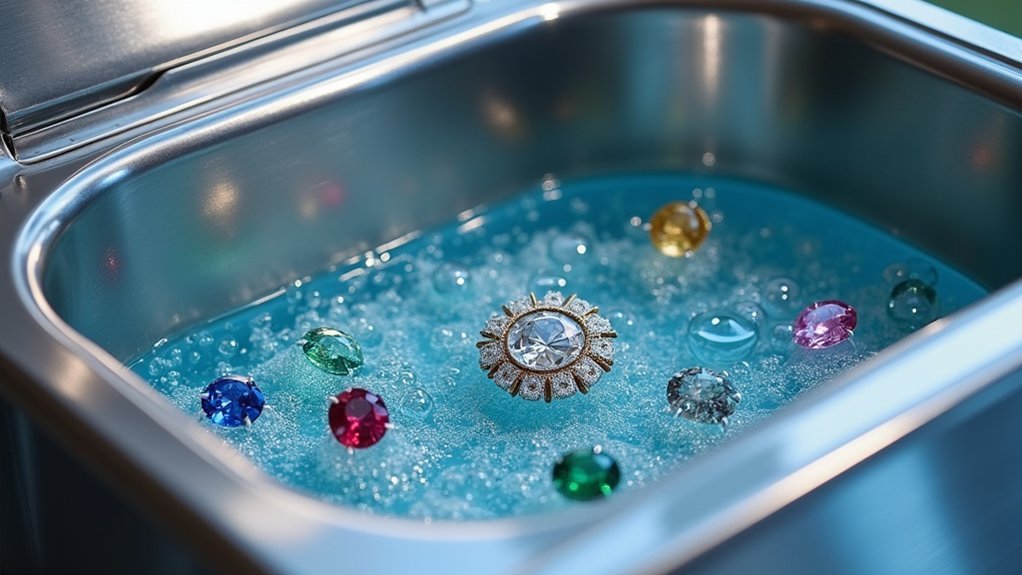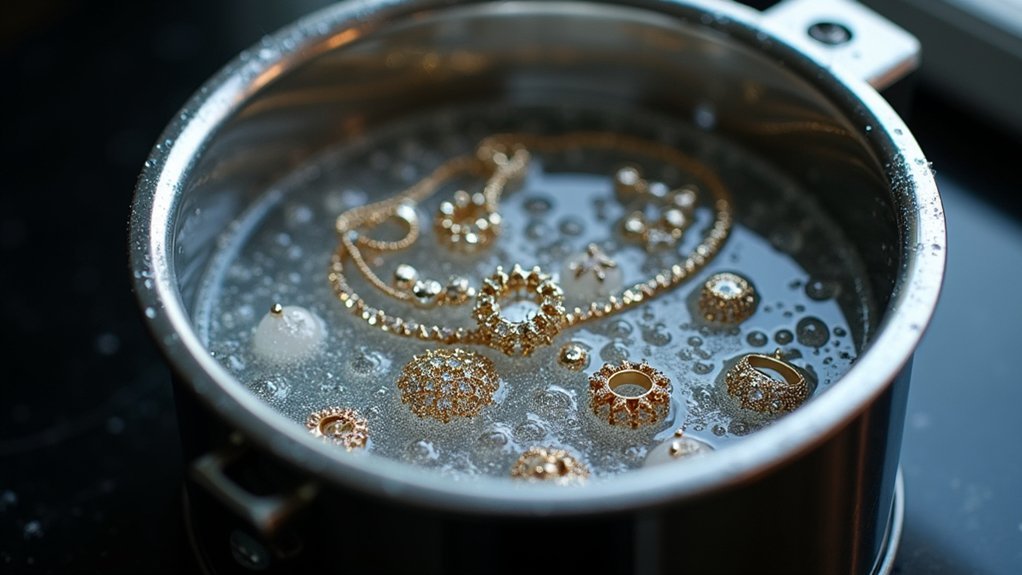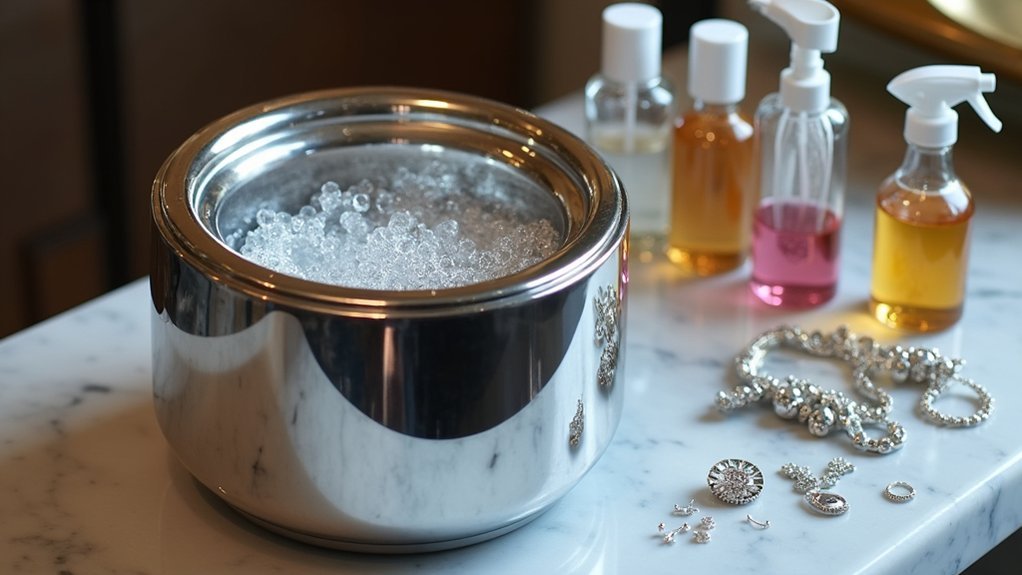You’ll achieve professional jewelry cleaning results using these five ultrasonic methods: high-frequency wave technology (40,000-50,000 Hz) that creates microscopic bubbles for deep cleaning, dual-chamber systems that customize solutions for different materials, temperature-controlled processing between 50°F-140°F for enhanced effectiveness, multi-stage protocols targeting various contamination types, and professional-grade solvent integration combining specialized chemicals with vibrations. These techniques safely restore delicate pieces and precious gemstones without damage while ensuring eco-friendly operation. Master these approaches to access the full potential of ultrasonic jewelry restoration.
High-Frequency Wave Technology for Deep Cleaning

When you need to clean intricate jewelry pieces thoroughly, high-frequency wave technology delivers unmatched results through its sophisticated cavitation process.
Operating between 40,000-50,000 Hz, this ultrasonic cleaning method creates microscopic bubbles that effectively dislodge dirt and grime from even the most detailed surfaces. You’ll achieve a deep clean without risking damage to delicate pieces or precious gemstones.
Microscopic bubbles generated at ultrasonic frequencies penetrate intricate jewelry details, delivering thorough cleaning while protecting delicate gemstones and precious metals.
This gentle cleaning approach guarantees your valuable jewelry remains pristine while dramatically improving cleaning efficiency. Most cycles complete within minutes, saving you considerable time compared to traditional methods.
The eco-friendly nature of ultrasonic cleaning means you’ll typically need only water and mild cleaning solutions, eliminating harsh chemicals that could harm both your jewelry and the environment while maintaining professional-grade results.
Dual-Chamber Ultrasonic Systems for Delicate Pieces
Two separate cleaning chambers give you unprecedented control when handling your most precious and delicate jewelry pieces.
Dual-chamber ultrasonic systems let you customize cleaning solutions for different materials, preventing damage that occurs with one-size-fits-all approaches. You’ll protect porous gemstones like pearls in gentler solutions while cleaning non-porous gemstones like diamonds with stronger formulations simultaneously.
Adjustable frequency settings guarantee you’re treating each jewelry type appropriately without compromising integrity.
These systems eliminate cross-contamination between cleaning solutions, maintaining ideal effectiveness for each chamber. User-friendly controls allow precise adjustments to cleaning time and intensity based on your specific needs.
You’ll achieve professional results while preserving the luster and structure of even your most fragile pieces through this advanced cleaning technology.
Temperature-Controlled Ultrasonic Processing

Temperature-controlled ultrasonic processing transforms your cleaning results by precisely managing water temperature to enhance both cleaning agent solubility and cavitation intensity.
When you maintain ideal cleaning temperatures between 50°F to 140°F, you’ll accelerate the cavitation process and achieve superior cleaning effectiveness.
You’ll benefit from consistent temperature throughout each cycle, ensuring uniform energy distribution across all jewelry surfaces. This prevents thermal shock while maximizing the ultrasonic waves’ ability in dislodging dirt and grime from intricate settings.
Advanced ultrasonic cleaners with built-in programmable heaters let you select specific temperatures for different materials.
This temperature-controlled approach proves especially valuable for delicate pieces, where you need gentle cleaning without compromising material integrity.
You’ll achieve faster, more thorough results while protecting your most fragile items.
Multi-Stage Ultrasonic Cleaning Protocols
Multi-stage ultrasonic cleaning protocols maximize your jewelry cleaning effectiveness by implementing sequential cycles that target different types of contamination.
You’ll start with lower frequencies around 28-40 kHz to gently loosen surface dirt and grime, then progress to higher frequencies up to 50 kHz for thorough cleaning of stubborn residues.
These cleaning cycles work exceptionally well for intricate jewelry designs, as high-frequency sound waves penetrate every crevice without manual scrubbing.
High-frequency sound waves reach deep into intricate jewelry settings where traditional cleaning methods simply cannot access.
You’ll enhance results by using specialized cleaning solutions formulated for specific metals and gemstones, which effectively dissolve oils, tarnish, and other contaminants.
Always conclude with a rinse cycle using distilled water to remove any remaining ultrasonic cleaning solutions, ensuring your jewelry achieves a spotless, professional finish.
Professional-Grade Solvent Integration Methods

While basic ultrasonic cleaning relies on water and sound waves, professional-grade solvent integration elevates your cleaning results by combining specialized chemical formulations with high-frequency vibrations.
Professional-grade ultrasonic cleaners utilize cleaning solutions containing surfactants and emulsifiers that break down oils and debris more effectively than water alone. When you combine these professional solvents with high-frequency sound waves around 40,000 Hz, you’ll create millions of microscopic bubbles that implode with powerful cleaning action.
This method works exceptionally well for intricate jewelry designs with hard-to-reach areas.
You’ll need to select solutions compatible with different metals and gemstones to prevent damage. The integration provides effective cleaning while greatly reducing manual scrubbing requirements, making maintenance more efficient for delicate pieces.
Frequently Asked Questions
Which Ultrasonic Cleaner Is Best for Jewelry Cleaners?
You’ll find the Sonic Soak performs best with its superior 50,000 Hz frequency, eliminating 99.9% of bacteria while offering eco-friendly operation. It’s travel-friendly and provides more meticulous cleaning than standard 42,000 Hz models.
What Do Professionals Use to Clean Jewelry?
You’ll find that professionals use ultrasonic cleaners operating at 40,000-50,000 Hz with specialized cleaning solutions. They’re perfect for diamonds and sapphires, but you shouldn’t use them on pearls or opals.
What Is the Best Hz for Cleaning Jewelry?
You’ll get the best results with 40,000-42,000 Hz for most jewelry cleaning. This frequency range effectively removes dirt and tarnish while staying gentle enough to protect delicate gemstones and intricate designs.
Do Ultrasonic Cleaners Really Clean Jewelry?
Yes, ultrasonic cleaners effectively clean jewelry using high-frequency sound waves that create microscopic bubbles. These bubbles implode and dislodge dirt from hard-to-reach areas you can’t access manually.
In Summary
You’ve now got five powerful ultrasonic methods that’ll transform your jewelry cleaning results. Whether you’re dealing with delicate vintage pieces or heavily tarnished items, these techniques will help you achieve professional-grade cleanliness. Don’t forget to match your method to your jewelry’s specific needs and always follow proper safety protocols. With the right ultrasonic approach, you’ll consistently deliver sparkling results that’ll impress your clients and protect their precious investments.





Leave a Reply